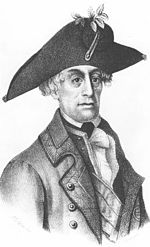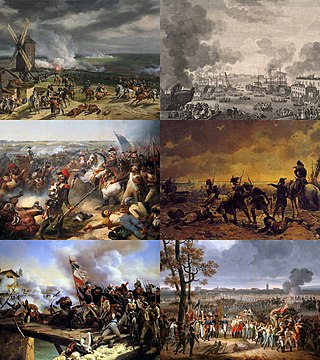
The War of the First Coalition was a set of wars that several European powers fought between 1792 and 1797, initially against the constitutional Kingdom of France and then the French Republic that succeeded it. They were only loosely allied and fought without much apparent coordination or agreement; each power had its eye on a different part of France it wanted to appropriate after a French defeat, which never occurred.

Charles-François du Périer Dumouriez was a French military officer, minister of Foreign Affairs, minister of War in a Girondin cabinet and army general during the French Revolutionary War. Dumouriez is one of the names inscribed under the Arc de Triomphe, on Column 3.

The Battle of Jemappes took place near the town of Jemappes in Hainaut, Austrian Netherlands, near Mons during the War of the First Coalition, part of the French Revolutionary Wars. One of the first major offensive battles of the war, it was a victory for the armies of the infant French Republic, and saw the French Armée du Nord, which included many inexperienced volunteers, defeat a substantially smaller regular Austrian army.

François-Étienne-Christophe Kellermann or de Kellermann, 1st Duke of Valmy was a French military commander, later the Général d'Armée, a Marshal of the Empire and freemason. Marshal Kellermann served in varying roles throughout the entirety of two epochal conflicts, the French Revolutionary Wars and the Napoleonic Wars. Kellermann is one of the names inscribed under the Arc de Triomphe, on Column 3.

The Battle of Valmy, also known as the Cannonade of Valmy, was the first major victory by the army of France during the Revolutionary Wars that followed the French Revolution. The battle took place on 20 September 1792 as Prussian troops commanded by the Duke of Brunswick attempted to march on Paris. Generals François Kellermann and Charles Dumouriez stopped the advance near the northern village of Valmy in Champagne-Ardenne.

The French Revolutionary Wars were a series of sweeping military conflicts lasting from 1792 until 1802 and resulting from the French Revolution. They pitted France against Britain, Austria, Prussia, Russia, and several other countries. They are divided in two periods: the War of the First Coalition (1792–1797) and the War of the Second Coalition (1798–1802). Initially confined to Europe, the fighting gradually assumed a global dimension. After a decade of constant warfare and aggressive diplomacy, France had conquered territories in the Italian Peninsula, the Low Countries and the Rhineland. French success in these conflicts ensured the spread of revolutionary principles over much of Europe.
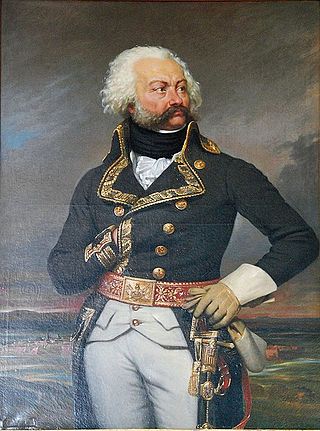
Adam Philippe, Comte de Custine was a French general. As a young officer in the French Royal Army, he served in the Seven Years' War. In the American Revolutionary War he joined Rochambeau's Expédition Particulière supporting the American colonists. Following the successful Virginia campaign and the Battle of Yorktown, he returned to France and rejoined his unit in the Royal Army.

Marshal Jean-Baptiste Donatien de Vimeur, comte de Rochambeau was a French nobleman and general whose army played a critical role in helping the United States defeat the British Army at Yorktown in 1781 during the American Revolutionary War. He was commander-in-chief of the French expeditionary force sent by France to help the American Continental Army fight against British forces.
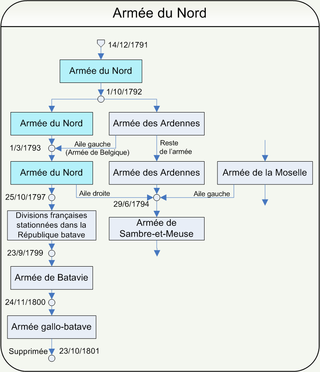
The Army of the North or Armée du Nord is a name given to several historical units of the French Army. The first was one of the French Revolutionary Armies that fought with distinction against the First Coalition from 1792 to 1795. Others existed during the Peninsular War, the Hundred Days and the Franco-Prussian War.

The French Revolutionary Army was the French land force that fought the French Revolutionary Wars from 1792 to 1804. These armies were characterised by their revolutionary fervour, their poor equipment and their great numbers. Although they experienced early disastrous defeats, the revolutionary armies successfully expelled foreign forces from French soil and then overran many neighboring countries, establishing client republics. Leading generals included Napoleon Bonaparte, Jean-Baptiste Jourdan, André Masséna and Jean Victor Marie Moreau.

The Brunswick Manifesto was a proclamation issued by Charles William Ferdinand, Duke of Brunswick, commander of the Allied army, on 25 July 1792 to the population of Paris, France during the War of the First Coalition. The manifesto threatened that if the French royal family were harmed, then French civilians would be harmed. It was said to have been a measure intended to intimidate Paris, but rather helped further spur the increasingly radical French Revolution and finally led to the war between Revolutionary France and counter-revolutionary monarchies.

Auguste Marie Henri Picot de Dampierre, styled the Marquis de Dampierre and usually known as Dampierre, was a French general during the time of the French Revolution. He served in many of the early battles of the War of the First Coalition, and was killed in action in 1793. His name is among those inscribed on the Arc de Triomphe.

The Army of the Centre was one of the first French Revolutionary Armies, named after the location it was set up, the Centre region. It was established by the order of King Louis XVI on 14 December 1791 and attached to Champagne. It had only an ephemeral existence after the Battle of Valmy and the Prussians' evacuation of the territory.

The Low Countries theatre of the War of the First Coalition, in British historiography better known as the Flanders campaign, was a series of campaigns in the Low Countries conducted from 20 April 1792 to 7 June 1795 during the first years of the War of the First Coalition. As the French Revolution radicalised, the revolutionary National Convention and its predecessors broke the Catholic Church's power (1790), abolished the monarchy (1792) and even executed the deposed king Louis XVI of France (1793), vying to spread the Revolution beyond the new French Republic's borders, by violent means if necessary. The First Coalition, an alliance of reactionary states representing the Ancien Régime in Central and Western Europe – Habsburg Austria, Prussia, Great Britain, the Dutch Republic, Hanover and Hesse-Kassel – mobilised military forces along all the French frontiers, threatening to invade Revolutionary France and violently restore the monarchy. The subsequent combat operations along the French borders with the Low Countries and Germany became the primary theatre of the War of the First Coalition until March 1796, when Napoleon took over French command on the Italian front.

The siege of Lille saw a Republican French garrison under Jean-Baptiste André Ruault de La Bonnerie hold Lille against an assault by a Habsburg army commanded by Duke Albert of Saxe-Teschen. Though the city was fiercely bombarded, the French successfully withstood the Austrian attack in the action. Because the Austrians were unable to completely encircle the city, the French were able to continuously send in reinforcements. After news of the French victory over the Prussians at Valmy, Albert withdrew his troops and siege cannons. The next battle was at Jemappes in November. The Column of the Goddess monument was completed in 1845 to commemorate the siege.
Events from the year 1792 in France.
The Battle of Marquain was a conflict between Austria and the Kingdom of France during the War of the First Coalition. It took place on 29 April 1792 and ended in a French defeat.

Jean Étienne Philibert de Prez de Crassier or Étienne Desprez-Crassier was a French political and military leader in the early years of the French Revolutionary Wars. Despite being from the minor nobility, he entered the French Royal Army as a cadet at the age of 12 because of his family's poverty. He fought in the War of the Austrian Succession and the Seven Years' War, becoming a colonel in 1785 and retiring two years later. Voltaire lent him the money needed to recover the Deprez family property. He was elected to the Estates General as a nobleman in 1789. After being promoted to lieutenant general he led a division at Valmy in 1792. He became commander of the Army of the Rhine and Army of the Western Pyrenees. Imprisoned during the Reign of Terror, he was released and restored to his former rank but retired in 1796.
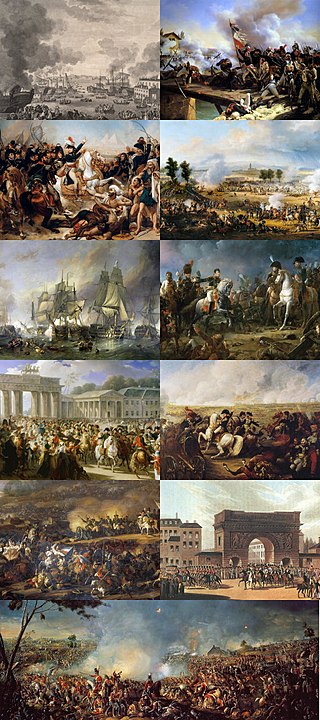
The French Revolutionary and Napoleonic Wars, sometimes called the Great French War, were a series of conflicts between the French and several European monarchies between 1792 and 1815. They encompass first the French Revolutionary Wars against the newly declared French Republic and from 1803 onwards the Napoleonic Wars against First Consul and later Emperor Napoleon Bonaparte. They include the Coalition Wars as a subset: seven wars waged by various military alliances of great European powers, known as Coalitions, against Revolutionary France – later the First French Empire – and its allies between 1792 and 1815:

